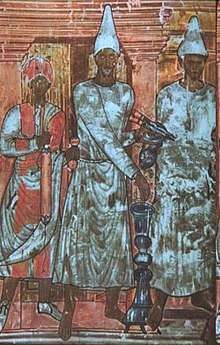Temple of Bel, Dura Europos
The Temple of Bel, also known as the Temple of the Palmyrene gods, was located in Dura Europos, an ancient city on the Euphrates, in modern Syria. The temple was established in the first century BC and is celebrated primarily for its wall paintings. Despite the modern names of the structure, it is uncertain which gods were worshipped in the structure. Under Roman rule, the temple was dedicated to the Emperor Alexander Severus. In that period, the temple was located within the military camp of the XXth Palmyrene cohort.


Discovery
The temple's paintings were discovered in 1920 by M. C. Murphy. Photos of them reached James Henry Breasted, who studied both the paintings and the temple and would publish a monograph about them in 1924.[1] Before Murphy's discovery, the site was unknown. Its identification with the town of Dura Europos, as known from ancient sources, only came later. The discovery of wall paintings in the temple sparked interest and the find was even reported in the New York Times, in an article from 10 June 1922. This article noted that the paintings represented a transitional stage between 'decadent Oriental Hellenistic art' and Byzantine art.[2]
Description
The temple is located in the northwest of the city, abutting the city wall. The northern and western walls of the temple are formed by the city wall. At least three construction phases can be discerned. The holy of holies was located in the west. The original construction phase consisted of a wide room, to which a vestibule was added in the second building phase. In front of the holy of holies was a courtyard, surrounded by various rooms, whose function is not yet clear. The main entrance to the temple was located on the east side of sanctuary, roughly opposite the holy of holies.[3]
Wall paintings
The temple is best known in scholarship on art history because of its wall paintings. At Dura Europos, relatively well-preserved wall paintings survived, many of them dating from the period when the city was under Roman rule (AD 164-256). The paintings in the holy of holies, known as the Sacrifice of Konon, however, date to the late first century BC or early first century AD, when the city was under Parthian rule. At the time of their discovery, they were very well-preserved and the colours remained very vivid. The paintings were removed from the wall and are now found in the National Museum of Damascus. A typical feature of these images is the stark frontal focus of the figures. The colours were originally very bright. The faces were particularly well-executed by the artists and appear to be portraits of specific individuals.[4] The figures are identified by small inscriptions next to them. From these it is learnt that the main figure is Konon and the other figures are several generations of his descendants.[5]
Another important wall painting is the Sacrifice of Julius Terentius. This painting dates to the period of Roman rule and shows Julius Terentius, who was the Tribune of the Roman garrison in Doura-Europos. Julius Terentius is located in the centre of the scene. In front of him, there is an altar and statues of three deities. These deities were initially identified with the Palmyrne gods, Yarhibol, Aglibol, and Malakbel, hence the modern English name of the temple. More recent research has revealed the statues of the Roman emperor, indicating that this was a centre of Imperial cult.[6] Below the statues, there are two female deities. These are depictions of Tyche (fortune). The inscription refers to them as the Tyche of Dura and the Tyche of Palmyra.[7]
References
- James Henry Breasted: Oriental Forerunners of Byzantine Painting: First-Century Wall Paintings from the Fortress of Dura on the Middle Euphrates. (= University of Chicago Oriental Institute Publications. Band 1). Chicago 1924, OCLC 886650055. (online)
- J. A. Baird: Dura Europos. Bloomsbury Academic, London 2018, ISBN 978-1-4725-3087-5, pp. 3–5.
- J. A. Baird: Dura Europos. 2018, p. 101.
- Lucinda Dirven: The Problem of Parthian Art at Dura. In: Ted Kaizer (Hrsg.): Religion, Society and Culture at Dura-Europos. Cambridge University Press, Cambridge/ New York 2016, ISBN 978-1-107-12379-3, pp. 68–88, esp. 81-82
- J. H. Breasted: Wall Paintings from the Fortress of Dura. 1924, pp. 85–86.
- Cristina Marta Acqua: Imperial Representation at Dura-Europos. In: Ted Kaizer (ed.): Religion, Society and Culture at Dura-Europos. Cambridge University Press, Cambridge/ New York/ Melbourne/ Delhi/ Singapore 2016, ISBN 978-1-107-12379-3, pp. 144–176, hier besonders 153-154
- J. H. Breasted: Wall Paintings from the Fortress of Dura. 1924, p. 98.